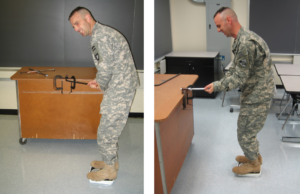Model Description
Introduce Varignon’s theorem to students as one way to determine the moment about a point. Show how moments are free vectors. This demonstration should take 10 minutes.
Engineering Principle
Varignon’s Theorem states that the moment of a force is equal to the sum of the moments of that force’s components about the same point.
where Perpendicular distance from the force’s line of action to the point.
What You Need
| Item | Quantity | Description/Clarification |
|---|---|---|
| Scale | 1 | A typical bathroom scale will do. $20 |
| Clamp | 2 | Two heavier duty clamps that can hold down the bolt holder apparatus. $8, each |
| Bolt and Nut | 1 | The head of the bolt should correspond approximately in size to a lug nut. $8 |
| Bolt Holder | 1 | This device is simply meant to hold the bolt and be clamped to a desk or windowsill. It consists of a hollow shaft, large enough in inner diameter to allow the above bolt through, welded to two flat plates that will be clamped down. $25; 30 minutes |
| Breaker Bar | 1 | A breaker bar designed for lug nut applications is required; typically, any breaker bar from a car’s spare tire assembly will work. $20 |
| Lug Wrench | 1 | Any type of lug wrench that has two equally spaced arms will do. $12 |
How It’s Done
In Class:
Introduce the concept of Varignon’s theorem in the context of changing a tire. The mounted nut is your lug nut on the tire. Using the breaker bar apply a moment to the nut, but push at an acute angle with respect to the longitudinal axis of the breaker bar. The definition of a moment included the perpendicular distance to the force’s line of action. If the force is not applied perpendicular to the breaker bar as the nut is turned, then it is difficult to calculate the distance without extensive geometry. Introduce Varignon’s Theorem to help at this point. Using the magnitude of the angle and the magnitude of the force applied to the breaker bar, calculate the moment. Choose these values carefully beforehand to prove the next point.
Contrast the Moment from a Couple with Moment from a Force
Calculate the Moment if using the lug wrench and the same total force magnitude as with the breaker bar. In this case though, the force is applied at two locations, so each hand applies ½ of the force. If the dimensions and forces are selected correctly, the Moment caused by the lug wrench will exceed that caused by the breaker bar.

Additional Application:
Show the Concept of Free Vector
Demonstrate the concept of a free vector now by having a student stand on the scale and apply an upward force to the breaker bar. The student’s weight should increase as long as the student keeps their lower body rigid. In contrast, when the same student applies an upward and downward force to the lug wrench, his/her weight should not change. This demonstrates the concept that there is no net force acting on the student. At this point, one can begin a discussion on the merits of each option and which might be better for the studs of the wheel.
